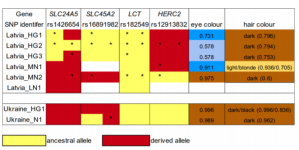Fire Haired14
Banned
- Messages
- 2,185
- Reaction score
- 583
- Points
- 0
- Y-DNA haplogroup
- R1b DF27*
- mtDNA haplogroup
- U5b2a2b1
New mtDNA from Stone age Eastern Europe(Latvia, Ukraine)
Post at my blog where I argue high frequencies of U5a, U4 in Eastern Europe today is partially due to ancestry from Eastern European hunter gatherers.
Post at my blog where I argue high frequencies of U5a, U4 in Eastern Europe today is partially due to ancestry from Eastern European hunter gatherers.






.gif)



